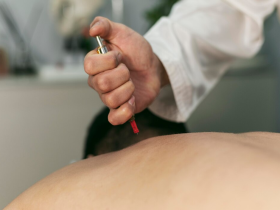An aortic aneurysm is a localised and permanent dilation of the artery responsible for carrying blood to the entire body and distributing it to the head, arms, all viscera and legs. This abnormal widening is caused by the weakness of the wall of an area of the blood vessel.
“We speak of an aneurysm when the size of the aortic artery is one and a half times larger than normal.
“The aorta artery leaves the heart and runs through the entire thorax in an ascending direction and the abdomen. Dilation can occur at any location: exit from the heart (ascending aortic aneurysm), at the descending thoracic level (descending thoracic aortic aneurysm ) and at the level of the abdomen ( abdominal aneurysm ), usually below the renal arteries. The latter is the most common and is diagnosed when the diameter of the artery exceeds 3 centimetres.
Prevalence
Various studies show that aortic aneurysms are present in 2-4% of people over 65 -mainly men- and 80% are in the abdominal aorta. However, the actual prevalence is difficult to calculate because most cases are asymptomatic.
Causes
The causes of aneurysms are not precisely known. Some are congenital. That is, they are present from birth.
Dilation can be triggered by some diseases, such as atherosclerosis, which weakens the aorta’s wall until the pressure inside this artery causes it to widen and bulge out.
Some of the most critical risk factors for the appearance of aortic aneurysms are the following:
- Advanced age.
- Male sex.
- Smoking.
- high blood pressure
- Hypercholesterolemia.
- Genetic diseases (such as Marfan syndrome ) and family history.
- Diabetes.
Symptoms
The big problem facing the proper treatment of aortic aneurysm is that it is a disease that, in most cases, does not cause symptoms. This is relevant because there are very effective treatments if detected early, but survival drops drastically when it becomes complicated.
The most feared complication is rupture of the aortic artery, which occurs when it reaches an excessive diameter. But during this process of progressive dilation, “no pain or warning sign that we can locate.” That aorta “is like a balloon that, as it swells, the risk of bursting is greater .” For this reason, when an aneurysm is located early because ultrasound is performed for another reason or because of family history, the patient is subjected to regular follow-up to prevent the problem.
It is estimated that this pathology can be asymptomatic in up to 75% of cases. The researcher warns that the remaining 25% “may have small non-specific discomforts, such as abdominal or lumbar pain, but a non-negligible number of them can debut with rupture of the aneurysm”.
The symptoms of a ruptured aneurysm, whose mortality is very high, can be summed up as “severe abdominal pain and drop in blood pressure that can cause loss of consciousness or shock. In this case, “we must quickly notify the emergency service.”
Prevention
The best way to try to prevent the possible appearance of an aneurysm is to change your lifestyle towards a healthier one that includes a balanced diet, such as the Mediterranean one. Specialists recommend controlling hypertension, quitting smoking and practising physical exercise regularly to reduce the chances.
In short, the cardiovascular risk factors that increase the chances of suffering a myocardial infarction or stroke, among other pathologies, also increase the chances of suffering an aortic aneurysm. That is why the recommendations of the experts are the same.
Aparicio recommends a review by a vascular surgeon for those with a history of cardiovascular disease, especially if they are over 60-65 years old. Likewise, it recommends those who have a relative who has suffered an aneurysm “that after the age of 50, they tell their GP to do an abdominal ultrasound and rule out the possibility that it is a case of the familial aneurysm.
Types
There are several types of aneurysm:
- Abdominal aortic aneurysm: It occurs in the segment of the aorta that runs through the abdomen. It usually measures more than 5 or 5.5 centimetres, so it is more likely to break.
- Thoracic aortic aneurysm: These types of aneurysms pass through the chest. The most frequent are those dilating from where it leaves the heart.
- Dissecting aneurysm or aortic dissection: In this case, the inner lining of the aorta is torn, but the outer lining remains intact, and when blood enters this conduit, it lifts the existing middle layer, thereby creating a new channel in the wall Aortic.
Diagnosis
In an aneurysm, pain is often a helpful symptom to diagnose the disease. Nevertheless, in most patients, pain manifests late and delays diagnosis.
There are many cases in which aneurysms do not present any symptoms. Therefore, they could only be seen in a physical examination, X-rays, or ultrasounds as part of another consultation. However, if the aneurysm has grown rapidly and is about to rupture, or if they are pressed during a medical examination of the abdomen, it will spontaneously hurt.
To diagnose an aneurysm, an abdomen x-ray may be done, which will show an aneurysm with calcium deposits on its wall; an ultrasound, which will establish the size of the aneurysm; a computed tomography (CT) scan or magnetic resonance imaging (MRI).
Treatments
Treatment is always surgical, both in uncomplicated and ruptured aneurysms. “Today, you can choose open or endovascular surgery -with much less operative risk-both with excellent results and advantages and disadvantages.
In open abdominal aortic aneurysm surgery, the abdomen is opened, and the affected aorta is replaced with a prosthesis. At the same time, the endovascular procedure introduces a type of stent or covered spring from the groin, from the groin to isolate the affected aorta. “It is less aggressive, and we reserve it for older patients.
Treatment will vary depending on the type of aneurysm the patient has:
- Abdominal aortic aneurysm
Treatment, in this case, depends on the size of the aneurysm. If the width is less than 5 centimetres, the chances of breaking are meagre. On the contrary, if it is greater than 5 centimetres, breakage will be more likely.
Surgical intervention is usually recommended for these cases unless there is an excellent risk for different medical reasons. The operation would consist of inserting a synthetic graft to repair the aneurysm. An emergency intervention should be carried out if it breaks or threatens to break. If a ruptured aneurysm is not treated, it is always fatal.
- Thoracic aortic aneurysm
Surgery must be performed to implant a synthetic graft if the aneurysm is more significant than 5 or 5.5 centimetres wide.
If the person has Marfan syndrome (a disease that affects the connective tissue and different organs), it is recommended to repair smaller aneurysms by surgery. These aneurysms carry a high risk of death during surgical repair.
- Dissecting aneurysm or aortic dissection
In this type, the specialist must prescribe drugs as soon as possible so that the heart rate and blood pressure are reduced but can continue to provide a sufficient supply of blood to the heart, brain and kidneys.
Once drug treatment has been started, the doctor will assess whether the treatment of choice will continue to be pharmacological therapy or if you will have to undergo surgery. In most cases, professionals recommend surgery for dissections located in the first few centimetres of the aorta unless there is excessive surgical risk.
Other symptoms:
If aneurysms are not diagnosed and treated, they can continue to grow. This implies a progressive increase in the chances that they will end up breaking and causing internal bleeding that can lead to the patient’s death.
Only half of those who suffer a rupture reach the hospital, and of those who reach the operating room, only 50% survive after surgery.
On the other hand, when the aneurysm is detected early and surgically intervened, the success rates of the surgery are very high, and the chances of being able to lead an everyday life are also very high.







